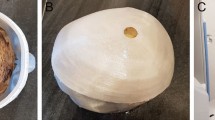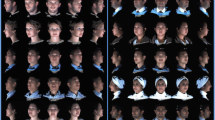Abstract
Objectives
Accurate registration and feasible fusion of a three-dimensional (3D) photorealistic surface images (captured using the FaceSCAN3D® Scientific Photo Lab) from multislice spiral computed tomography (MSCT) images is important to achieve optimal craniomaxillofacial surgery outcomes; thus, the aim of this work was to optimize this process.
Methods
MSCT and 3D facial scans were acquired from 37 randomly selected patients. Using the Invesalius software package, skin and bone tissue models were reconstructed. The 3D photorealistic surface images were then constructed. Four image registration processes were performed using Geomagic Studio software: manual Procrustes and semi-automatic registration (global modified ICP) using both 7 and 15 anthropometric landmarks. The statistical differences were assessed using one-way ANOVA and LSD tests. P values <0.05 were considered significant.
Results
Average distances between these two surfaces measured 0.99 (SD 0.13 mm), 0.77 (SD 0.11 mm), 0.99 (SD 0.15 mm), and 0.77 mm (SD 0.10 mm) via the four image registration methods. Statistical differences were observed between the manual and semi-automatic registration groups (according to 7 and 15 anthropometric landmarks, respectively). Image registration errors for the entire virtual face were <0.8 mm in the semi-automatic registration groups.
Conclusion
Employing the Procrustes registration system using seven anthropometric landmarks together with global registration allows accurate registration and feasible fusion of 3D facial scans with reconstructed 3D MSCT image data.
Zusammenfassung
Ziele
Der Prozess der genauen Registrierung und der praktikablen Fusion von fotorealistischen 3-D-Oberflächenbildern (FaceSCAN3D® Scientific Photo Lab) mit MSCT(“multislice spiral computed tomography”)-Bilddatensätzen ist von hoher Relevanz für optimale Ergebnisse bei kraniomaxillofazialen operativen Interventionen. Daher war es Ziel der Arbeit, diesen Prozess zu optimieren.
Methoden
Von 37 randomisiert ausgewählten Patienten wurden MSCT- und 3-D-Gesichtsscans erstellt. Mit der Software InVesalius wurden Haut- und Knochenmodelle rekonstruiert. Die fotorealistischen 3-D-Oberflächenbilder wurden rekonstruiert. Mit der Software Geomagic Studio wurden 4 Registrierungsprozesse vorgenommen: manuelle Prokrustes- und semiautomatische Registrierung (“global modified ICP”, Iterative Closest Point) unter Verwendung von sowohl 7 als auch 15 anthropometrischen Landmarken. Statistische Unterschiede wurden mit dem Ein-Wege-ANOVA(“analysis of variance”)- und dem LSD (“least significant difference”)-Test ermittelt. Als signifikant definiert wurden p-Werte <0,05.
Ergebnisse
Die durchschnittlichen Entfernungen zwischen den 2 gemessenen Oberflächen lagen bei 0,99 (SD 0,13 mm), 0,77 (SD 0,11 mm), 0,99 (SD 0,15 mm) und 0,77 mm (SD 0,10 mm) bei den 4 eingesetzten Bildregistrierungsmethoden. Zu beobachten waren statistische Unterschiede zwischen den Gruppen mit manueller und semiautomatischer Registrierung (an 7 bzw. 15 anthropometrischen Landmarken). Die Registrierungsfehler für das gesamte virtuelle Gesicht waren in den semiautomatischen Registrierungsgruppen geringer als 0,8 mm.
Schlussfolgerungen
Das Prokrustes-Registrierungssystem mit 7 anthropometrischen Landmarken ermöglicht in Verbindung mit einer globalen Registrierung die genaue Registrierung und machbare Fusion dreidimensionaler Gesichtsscans mit rekonstruierten 3-D-MSCT-Bilddaten.





Similar content being viewed by others
References
Adolphs N, Haberl E-J, Liu W, Keeve E, Menneking H, Hoffmeister B (2013) Virtual planning for craniomaxillofacial surgery—7 years of experience. J Cranio-Maxillofac Surg
Ayoub AF, Xiao Y, Khambay B, Siebert JP, Hadley D (2007) Towards building a photo-realistic virtual human face for craniomaxillofacial diagnosis and treatment planning. Int J Oral Maxillofac Surg 36:423–428
Billings S, Taylor R (2014) Iterative most likely oriented point registration. Med Image Comput Comput Assist Interv 17:178–185
Gelesko S, Markiewicz MR, Weimer K, Bell RB (2012) Computer-aided orthognathic surgery. Atlas Oral Maxillofac Surg Clin 20:107–118
Govindu VM, Pooja A (2014) On averaging multiview relations for 3D scan registration. IEEE Trans Image Process 23:1289–1302
Grauer D, Cevidanes LS, Proffit WR (2009) Working with DICOM craniofacial images. Am J Orthod Dentofac Orthop 136:460–470
Hu Y, Li H, Qiao G, Liu H, Ji A, Ye F (2011) Computer-assisted virtual surgical procedure for acetabular fractures based on real CT data. Injury 42:1121–1124
Jayaratne YS, McGrath CP, Zwahlen RA (2012) How accurate are the fusion of cone-beam CT and 3-D stereophotographic images? PLoS One 7:e49585
Khambay B, Nebel JC, Bowman J, Walker F, Hadley DM, Ayoub A (2002) 3D stereophotogrammetric image superimposition onto 3D CT scan images: the future of orthognathic surgery. A pilot study. Int J Adult Orthod Orthognath Surg 17:331–341
Nahm KY, Kim Y, Choi YS, Lee J, Kim SH, Nelson G (2014) Accurate registration of cone-beam computed tomography scans to 3-dimensional facial photographs. Am J Orthod Dentofac Orthop 145:256–264
Naudi KB, Benramadan R, Brocklebank L, Ju X, Khambay B, Ayoub A (2013) The virtual human face: superimposing the simultaneously captured 3D photorealistic skin surface of the face on the untextured skin image of the CBCT scan. Int J Oral Maxillofac Surg 42:393–400
Noh H, Nabha W, Cho JH, Hwang HS (2011) Registration accuracy in the integration of laser-scanned dental images into maxillofacial cone-beam computed tomography images. Am J Orthod Dentofac Orthop 140:585–591
Plooij JM, Maal TJ, Haers P, Borstlap WA, Kuijpers-Jagtman AM, Berge SJ (2011) Digital three-dimensional image fusion processes for planning and evaluating orthodontics and orthognathic surgery. A systematic review. Int J Oral Maxillofac Surg 40:341–352
Popat H, Richmond S, Drage NA (2010) New developments in: three-dimensional planning for orthognathic surgery. J Orthod 37:62–71
Saad A, Winters R, Wise MW, Dupin CL, St Hilaire H (2013) Virtual surgical planning in complex composite maxillofacial reconstruction. Plast Reconstr Surg 132:626–633
Schendel SA, Duncan KS, Lane C (2011) Image fusion in preoperative planning. Facial Plast Surg Clin N Am 19:577–90 vii
Terzic A, Schouman T, Scolozzi P (2013) Accuracy of morphological simulation for orthognatic surgery. Assessment of a 3D image fusion software. Rev Stomatol Chir Maxillofac Chir Orale
Tzou CH, Frey M (2011) Evolution of 3D surface imaging systems in facial plastic surgery. Facial Plast Surg Clin N Am 19:591–602 vii
Uechi J, Tsuji Y, Konno M, Hayashi K, Shibata T, Nakayama E, Mizoguchi I (2014) Generation of virtual models for planning orthognathic surgery using a modified multimodal image fusion technique. Int J Oral Maxillofac Surg
Acknowledgments
This study was funded by the Chinese National 863 Program (2013AA040804).
Author information
Authors and Affiliations
Corresponding authors
Ethics declarations
All studies on humans described in the present manuscript were carried out with the approval of the responsible ethics committee and in accordance with national law and the Helsinki Declaration of 1975 (in its current, revised form). Informed consent was obtained from all patients included in studies.
Conflict of interest
Zhong Wei Zhou, Peng Li, Jia Yin Ren, Ji Xiang Guo, Yongqing Huang, Wei Dong Tian, and Wei Tang state that there are no conflicts of interest.
Additional information
Z. W. Zhou and P. Li contributed to the study equally.
Rights and permissions
About this article
Cite this article
Zhou, Z., Li, P., Ren, J. et al. Virtual facial reconstruction based on accurate registration and fusion of 3D facial and MSCT scans. J Orofac Orthop 77, 104–111 (2016). https://doi.org/10.1007/s00056-016-0014-8
Received:
Accepted:
Published:
Issue Date:
DOI: https://doi.org/10.1007/s00056-016-0014-8




